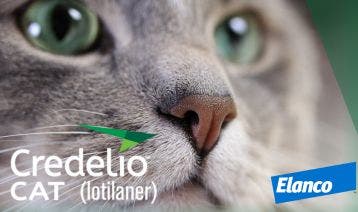Setting up for microchipping success: stress-free vet visits for cats and kittens
There are currently an estimated 2.6 million cats without a microchip in the UK1. The government announced changes in legislation, making the microchipping of cats compulsory in England. It is likely you will see an influx to your practice in May, as the deadline looms for June 2024. The change in legislation follows the compulsory microchipping of horses and dogs over the last few years and will also include compulsory storage of owner details on a government approved database.
What does this mean for your cat owner clients?
Microchipping adds further assurance to collars and tags, to ensure pet owners can be reunited with their cat. After 10th June 2024, it will be mandatory for all cats over 20 weeks old to be microchipped. If owners fail to have their cat chipped it can result in a £500 fine. The new cat microchipping law has largely been met with a positive response by both pet owners and professional veterinary organisations. With vets frequently being pet owners themselves, they are often acutely aware of the characteristics of cat curiosity and how there’s nothing worse than sitting and waiting for your pet to come home.
What does this mean for your practice?
Are you part of a cat-friendly clinic? Having a separate area set up for pet owners and their cats can help to reduce the stress of cats going to the vet. If you don’t, it can be particularly useful to have a temporary set up in the waiting area, especially if there is going to be a higher percentage of cat visitors over the next few months. The microchipping legislation also presents the opportunity to perform a physical exam and assess current prescription needs; are you linking your appointments for microchipping with vaccinations, parasite prevention, or scheduling annual health checks and neutering? Are you aligning the increase in cat visits with the opportunity to discuss health care plans?
We spoke with Feline Specialist Sarah Caney and Dr Carolyn Kyte, MRCVS, UK Technical Consultant at Elanco, to get their tips and myth-busting tricks when it comes to setting kittens up for success in those initial appointments. Sarah notes small kittens can be wriggly and tricky to restrain, but also explains “we can exploit that curiosity, that developmental stage that these young individuals are at, to make sure that we expose them to as many types of formulations of not only food, but also treats, so that when it comes to us wanting to perhaps later intermingle some of these things with medications - it helps set us up for success”.
Fewer kittens are currently vaccinated than puppies.2 Therefore, kittens may potentially present for the first time at a practice for microchipping. It is worth considering the order of discussions and optimising medications at the appointment itself. For example, if you are planning to prescribe parasite prevention at the same time as microchipping, then chewable treatments could be a great choice for pet owners to avoid topical applications where the microchip may be implanted. Equally, for cats less familiar with vet practices, or coming to the practice for the first time, they can be sent home with parasiticides for administration at home. There are many options available with spot-ons, collars and chewable treatments, which can be given easily with food or alongside tasty treats.
What does this mean for cats?
But why do cats do what they do? And why can a visit to the vet or treatment time cause them stress? Opportunities should be found for socialisation and habituation, especially during the “sensitive” period that kittens undergo between 2 and 8 weeks. Even if the kitten doesn’t go to a new home until after this, there are still ongoing opportunities to build their character and adaptability, for example positive associations with people and other animals should be built during a socialisation period from when kittens are 8-9 weeks old. Reinforcing experiences for socialisation should continue for their first year of life, to help cement behaviours and preferences. New experiences should ideally be encouraged alongside something positive, while the kitten is calm and relaxed. Kittens in particular benefit from early exposure and new experiences – visits to the vet for routine care and parasiticide prescription can be a part of this.
For older animals, habituation is about learning to be comfortable and relaxed with their environment, so every vet visit provides the opportunity to reinforce a positive association. Carolyn Kyte explains: “We need to make giving a cat medication a positive experience whenever possible. A fantastic outcome is when we can turn it into a bonding experience between cat and owner - that is beneficial for everyone involved.”
How can vets set up cat owners for success?
Setting up stress-free consults for both microchipping and ongoing treatment is important for new cat visits. “We are more and more seeing the impact of stress in cats” says Sarah Caney. “If owners witness their cats being stressed, it has a really significant negative impact on them”. However, we are seeing more cat-friendly treatment formulations, and innovations in microchipping that allow stress to be minimised in practice.
Chip takeaways:
- On 10th June 2024, it will be mandatory for all cats over 20 weeks old to be microchipped.
- There are 2.6 million cats without a microchip in the UK.1
- If pet owners fail to have their cat chipped, it can result in a £500 fine.
- 15% of cat owners will lose their pet over a 5 year period, and a microchipped cat is 21x more likely to be reunited with its owner.4
- Did you know that cat theft has risen by 40% and quadrupled between 2015 and 20215
- Tracer™ Advance from Elanco is one of the UK's leading microchip choices among veterinary professionals.
- Consider combining microchip appointments with other preventative medicine discussions, such as parasiticides. Did you know Credelio™ is licensed for kittens from 8 weeks old and from 500g?
Stress free-microchipping tips:
- Is your clinic being proactive to communicate with owners and get older cats in before the deadline? This could create an impact with scheduling appointments for both new and existing clients.
- Set up owners for success. Choose a trusted animal identification system to reunite lost pets with their owners quickly and efficiently.
- Some microchips have easy, ready to use implanters, providing convenience for you and your wider vet teams with set up. Most implanters are detachable and recyclable (subject to local recycling facilities).
- Microchips with a longer reading distance, such as those made with a bio-polymer rather than glass, will make scanning for chips easier in the consult.
- Having a missing cat is a highly stressful event for owners. Does the microchip you use include lifetime registration with online databases? Having facilities for automatic registration in practice minimises the chance of having an unregistered chip.
- Tracer™ Advance from Elanco does all of the above. It is one of the UK’s leading microchip choices among veterinary professionals. Find out more here.
Stress-free treatment tips:
- It is ideal to introduce a kitten to treatments at home with some cuddles and play, which is more likely to be a positive experience. Chewables can be given alongside treats*, which can be a more positive experience than being sprayed or having a potentially messy spot-on.
- Expose kittens to a variety of food and treat types. Kittens weaned on to varied diets can aid in broadening their food preferences throughout life. This can be beneficial should a cat need a vet-prescribed diet or a medication that can be given with food or treats.
- The owner of a new kitten who has no previous (or recent) experience of keeping a cat, may be more open to trying innovative products, created especially for cats.
- Did you know, cats lack a sweet taste receptor and only have about 500 taste buds, compared to around 2000 in dogs and 9,000 in humans.3 Because of the low numbers of taste buds, cats use other senses, most importantly smell, to assess food. Vanilla and yeast flavourings include aromatic compounds, which are appealing to the cat’s sense of smell.
- Consider parasiticides that won’t restrict handling/cuddling/sleeping on owner’s bed, like an oral chewable (always check the product SPC). Many kittens are part of a family, often with children, and this can interfere with the pet and owner bond.
- If thinking about combining parasiticides with microchipping and including an ongoing prescription for the next 12 months, choose a treatment licensed for young kittens, such as those from 8 weeks old and with a low weight such as 500g.
- Consider prescribing Credelio™ for cats from Elanco, to the next kitten registered at your practice. Credelio does all of the above. Find out more here.
- A new kitten will have no previous experience of being “pilled” or medicated, and may be more likely to accept a cat friendly medication like Credelio.
We asked Carolyn Kyte about the latest feline innovations, and she said: “We now have some very cat friendly formulations of medication. For example, Credelio Cat has been designed especially for cats to ease treatment of ticks and fleas. The tablets are tiny and tasty making them easy to give. If we can enable owners to medicate their cats at home with preventative treatments like Credelio Cat, then we are setting them up for success when they need to treat their cats during an illness or with longer term medication.”

Credelio for Cats
Find out more about treating ticks and fleas with stress-free ease with Credelio™.

Tracer Advance
Learn more about the Tracer Advance microchip and database package that helps your clients to keep track of their pet.

Testimonial Video for Vets
A video to show vets that giving a Credelio chewable tablet to cats doesn’t have to be a big 'to-do'. Video duration: 30 sec
*Credelio for cats should be given with food or within 30 minutes of feeding.
- GOV.UK 23 December 2020. https://www.gov.uk/government/news/cat-microchipping-consultation-launched
- BSAVA. 2017. PAW report. https://www.bsava.com/wp-content/uploads/2022/02/PDSA-PAW-Report-2017_online.pdf 65 “75% of dogs (7.0 million) and 65% of cats (6.7 million) received a primary vaccination course when young”
- Pet MD. 2022. https://www.petmd.com/cat/nutrition/can-cats-taste-sweet-things
- Dingman PA, Levy JK, Rockey LE, Crandall MM. Use of visual and permanent identification for pets by veterinary clinics. Vet J. 2014; 201(1):46-50
- Pet Theft Awareness: Cat Theft Report 2021. https://pettheftawareness.blogspot.com/2022/03/the-cat-theft-report-2022.html